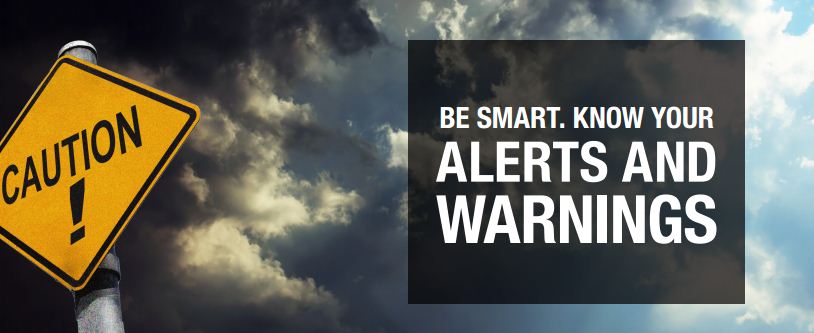KNOW YOUR ALERTS AND WARNINGS
Receiving timely information about weather conditions or other emergency events can make all the difference in knowing when to take action to be safe. Local police and fire departments, emergency managers, the National Weather Service (NWS), the Federal Emergency Management Agency (FEMA), the Federal Communications Commission (FCC), the National Oceanic and Atmospheric Administration (NOAA), and private industry are working together to make sure you can receive alerts and warnings quickly through several different technologies no matter where you are–at home, at school, at work, or in the community. For those with access and functional needs, many messages are TTY/TDD compatible and many devices have accessible accommodations.
Review this fact sheet to make sure you will receive critical information as soon as possible so you can take action to be safe. Be sure to share this information with your family, friends, and colleagues. And remember to keep extra batteries for your mobile phone or radio in a safe place or consider purchasing other back-up power supplies such as a car, solar-powered, or hand crank charger.
IPAWS INTEGRATED PUBLIC ALERT AND WARNING SYSTEM Organized by FEMA, the Integrated Public Alert and Warning System (IPAWS) is the Nation’s alert and warning infrastructure. It provides an effective way to alert and warn the public about emergencies using the Emergency Alert System (EAS), Wireless Emergency Alerts (WEA), NOAA Weather Radio All Hazards, and other public alerting systems from a single interface. IPAWS is used to send notifications for three alert categories— Presidential, AMBER, and Imminent Threat. For more information on IPAWS, EAS, and WEA, visit www.ready.gov/alerts.
Using IPAWS, officials can send messages simultaneously through multiple pathways, including: –
EAS: used by alerting authorities to send detailed warnings to broadcast, cable, satellite, and wire line communication pathways; –
WEA: Free, 90-character emergency text messages sent by local alerting authorities to equipped mobile devices within range of cell towers broadcasting in the affected area. You do not have to sign up for WEA alerts. To find out if your mobile device is capable of receiving WEA alerts, contact your cellular service provider or visit www.ctia.org/WEA and –
IPAWS compliant digital road signs, sirens, and other systems.
NOAA WEATHER RADIO ALL HAZARDS The NOAA Weather Radio All Hazards, or NWR, is a nationwide network of radio stations broadcasting forecasts, warnings, and emergency information 24 hours a day. It is a comprehensive weather and emergency information service available to the public. All-hazards messages include weather events, technological incidents like chemical spills, AMBER alerts, and national emergencies. NWR also broadcasts EAS notices. A special weather radio receiver is required to receive NWR broadcasts. You can buy these receivers at many retail outlets such as electronics stores, department stores, big box stores, or online. Be sure to look for the Public Alert or NWR logo to ensure the radio meets technical requirements. Models identified as SAME, or Specific Area Message Encoding, receivers allow users to select alerts for specific geographic areas. For information on NOAA Weather Radio All Hazards, visit www.nws.noaa.gov/nwr.
LOCAL JURISDICTION EMERGENCY NOTIFICATION SYSTEMS OPT-IN/SIGN-UP TEXT AND EMAIL SYSTEMS Many jurisdictions have opt-in public alert and warning systems. An opt-in system means you must sign up to receive the alert. Once you have signed up, officials in your area can send you text or email messages about local emergencies. Most opt-in systems allow subscribers to choose the devices that receive alerts as well as the types of alerts. Because you may not be near a television or radio when something happens, a local text or email alert can be an extremely useful source for critical information. Small costs may be associated with receipt of text messages from your mobile device service provider. To find out what alerts are available in your area, you can do an Internet search with your town, city, or county name and the word “alerts”; you can go to the website for your local emergency management or public safety office; or you can contact these offices by telephone.
ENHANCED TELEPHONE NOTIFICATION (ETN) SYSTEMS In the event of an emergency, local officials in many local communities can send warning messages and instructions to individuals in an at-risk area through an ETN system, such as a Reverse 911® system. Most systems include landline phone numbers, but some also allow for messages to Voice over Internet Protocol (VoIP) and mobile phones through an opt-in process—check with your local emergency management for information on this system and available features.
OUTDOOR SIRENS AND/OR VOICE ALERT SYSTEMS Outdoor sirens and/or voice alert systems are used to alert people outdoors of an immediate danger so they can take cover. The system is not designed to be heard inside building walls. Note that some communities may still have the siren infrastructure in place but it may no longer be operable, so it is important to check with your local emergency management office to understand if this service is currently provided.
LOCAL SCHOOL OR ORGANIZATION NOTIFICATION SYSTEMS Many workplaces, schools, and community- and faith-based organizations have notification systems to warn individuals of emergencies and provide tailored notifications. These may range from listservs to opt-in text and email systems similar to those used by local jurisdictions.
MOBILE APPS WITH LOCAL ALERT FUNCTIONS FEMA APP Stay updated with severe weather alerts from the National Weather Service for up to five locations across the U.S.; learn how to stay safe before, during, and after over 20 types of hazards; save a custom list of the items in your family’s emergency kit; and locate and receive driving directions to open shelters and disaster recovery centers. You can also submit disaster-related photos to a public map using the Disaster Reporter feature. The FEMA App is also available in Spanish. Download the app to your mobile device or smartphone free on iTunes or Google Play. Learn more at www.fema.gov/mobile-app.
AMERICAN RED CROSS APP The Red Cross Emergency app combines more than 35 different types of severe weather and emergency alerts. You can choose the alerts that are important to your location or the location of loved ones. The “Family Safe” feature allows you to notify loved ones that an alert has been issued in their area and check to see if they are safe. The app also offers information on what to do before, during, and after severe weather hits and how to find open Red Cross Shelters. All content is also available in Spanish. You can download the app to your mobile device or smartphone free on iTunes (Apple-iOS 6.0 or later) and Google Play (Android). Learn more at www.redcross.org/prepare/mobile-apps.
THE WEATHER CHANNEL APP Tracks weather and provides local forecasts and push alerts of severe weather to your mobile device. Download the app to your mobile device or smartphone free on iTunes (Apple-iOS 6.0 or later), Google Play (Android), App World (BlackBerry), and Windows Phone at www.weather.com/apps.
SUMMARY OF ACTIONS FOR INDIVIDUALS – Confirm your mobile device can receive Wireless Emergency Alerts. – Sign up for text and/or email alerts from your local jurisdiction. – Consider purchasing a NOAA Weather Radio All Hazards. – If you do not have a landline, check to see if your jurisdiction has options for VoIP and mobile phones to be connected to ETN systems such as Reverse 911. – Sign up for listservs and alerts for the workplace, schools, houses of worship, or other community organizations you’ll want to hear from in an emergency. – Download relevant hazard alerts and warnings apps. – Create a list of all the alert systems available to you, and make sure everyone in the household receives the alerts as part of your household communication system.
FOR ORGANIZATIONS – Test internal communication systems to ensure all individuals in the organization can be contacted. – Designate individuals to be responsible for distributing alerts from official sources. – Consider purchasing a NOAA Weather Radio All Hazards. – Develop a list of all the alert systems available for your community and your organization as a guide for people in the organization. – Encourage individuals to sign up for alerts and warnings, and assist them with finding any needed information. The reader recognizes that the Federal Government provides links and informational data on various disaster preparedness resources and events and does not endorse any non-Federal events, entities, organizations, services, or products.
Assemble or Update Supplies Get Involved in Your Community Sign up for Alerts and Warnings Plan with Neighbors Make a Plan Make Your Home Safer Document and Insure Property


Leave a Reply